Conservation Techniques for Cultural Properties
In 1975 the Japanese government added a new chapter to the Law for the Protection of Cultural Properties (1950) to provide for "traditional techniques or craftsmanship that are indispensable to the preservation of cultural property and for which preservation measures shall be taken". Preservation techniques are selected in relation to both tangible and intangible cultural properties and a holder or preservation body is recognized for each technique.[1][2][3]
In support of the Selected Conservation Techniques (選定保存技術), the government provides funding for and conducts programmes relating to documentation, training, development, promotion and public education. Recognition is thus made and measures taken to combat some of the most serious conservation issues, namely the lack of specialist craftsmen, the loss of knowledge of traditional techniques, and the availability of suitable tools and materials. These issues are of particular relevance in Japan due to the sophistication and inherent susceptibility of much of its art and architecture.[2][3]
The list below is compiled from the database of cultural properties maintained by the Agency for Cultural Affairs, with translations, glosses and listed holders (as of 2004) following those published by the Asia/Pacific Cultural Centre for UNESCO (ACCU).[4][5]
Selected Conservation Techniques
Tangible Cultural Properties
43 techniques
| Name | Remarks | Holder | Year | Picture |
|---|---|---|---|---|
| Production of roofing tiles (屋根瓦製作 (鬼師) yane kawara seisaku (onishi))[6][7] | Onigawara | Individual (Akio Kobayashi, b. 1921) | 1988 |  |
| Kiku-jutsu techniques for marking when constructing wooden building (modern) (規矩術 (近世規矩) kiku-jutsu (kinsei-kiku))[8][9] | lit. "measuring with a carpenter's square" | Individual (Takeo Mochida, b. 1931) | 1993 | |
| Kiku-jutsu techniques for marking when constructing wooden building (ancient) (規矩術 (古式規矩) kiku-jutsu (koshiki-kiku))[3][10] | In particular for projecting eaves; developed since the twelfth century | Individual (Takeo Mochida, b. 1931) | 1991 | |
| Smithery of metal fittings (金具鍛冶 kanagu kaji)[11][12] | Individual (Mayoshio Yokoya, b. 1931) | 2002 | 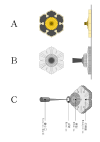 | |
| Manufacture of kinkarakami (金唐紙製作 kinkarakami seisaku)[13][14][15] | Gold-embossed wallpaper, used in western-style buildings of the Meiji to Shōwa periods; cf. kinkarakawa or 'leather wallpaper' | Individual | 2005 | |
| Making of traditional fittings such as sliding doors (建具製作 tategu seisaku)[16][17] | Includes shōji, fusuma, amado | Individual (Tadashi Suzuki, b. 1936) | 1999 |  |
| Production of model buildings (建造物模型製作 kenzōbutsu mokei seisaku)[18] | Individual (Yushuhiro Wada, b. 1932) | 1999 | 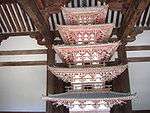 | |
| Restoration of armour (甲冑修理 katchū shūri)[19] | Individual (Masami Ozawa, b. 1953) | 1998 |  | |
| Plastering (traditional Kyokabe walls) (左官 (古式京壁) sakan (koshiki kyō-kabe))[20] | Individual (Haruo Sato, b. 1924) | 2001 |  | |
| Plastering (左官 (漆喰塗) sakan (shikkuinuri))[21][22] | Glue, brine, clay, and thread are mixed into the lime | Individual (Isokichi Okui, b. 1919) | 1998 | |
| Restoration of lacquer wares (漆工品修理 shikkōhin shūri)[23][24] | Individual (Kenichi Kitamura, b. 1938) | 1994 | 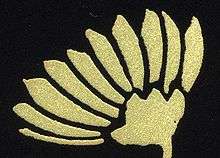 | |
| Crafting and restoration of metal fittings of Jōdai ornaments (上代飾金具製作修理 jōdai kazari kanagu seisaku shūri)[25] | Includes mikoshi, zushi | Individual (Sōtaro Kanae, b. 1908) | 1977 |  |
| Manufacture of tatami (畳製作 tatami seisaku)[26] | Individual | 1929 | 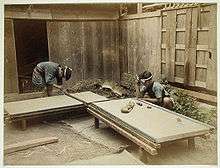 | |
| Stone tile roofing (石盤葺 sekibanbuki)[27] | Individual | 2005 | ||
| Production of nails made of bamboo (竹釘製作 takekugi seisaku)[28][29] | Individual (Yoshiharu Ishizuka, b. 1922) | 1998 | ||
| Casting production (鋳物製作 imono seisaku)[30] | Individual (Shūichi Otani, b. 1933) | 1999 | ||
| Production of karakami paper (唐紙製作 karakami seisaku)[31][32] | Individual (Kenkichi Senda, b. 1942) | 1999 | ||
| Manufacture of boxes made of paulownia wood for containing art and craft objects (美術工芸品保存桐箱製作 bijutsu kōgeihin hozon kiribako seisaku)[33] | Individual (Yūichi Maeda, b. 1927) | 1980 | ||
| Manufacture of ancient textiles (such as gold brocade) for mounting (表具用古代裂 (金襴等) 製作 hyōgu-yō kodai-gire (kinran tō) seisaku)[34][35][36][37] | For kakemono etc. | Individual | 2007 | |
| Manufacture of brushes for mounting (表具用刷毛製作 hyōguyō hage seisaku)[38][39] | Individual | 1958 | ||
| Production of Udagami handmade paper for mounting on sliding doors (表具用手漉和紙 (宇陀紙) 製作 hyōguyō tesuki washi (udagami) seisaku)[40] | washi | Individual (Hiroyuki Hukunishi, b. 1930) | 1978 | |
| Production of Misugami handmade paper for mounting (表具用手漉和紙 (美栖紙) 製作 hyōguyō tesuki washi (misugami) seisaku)[41] | washi | Individual | 2009 | |
| Production of Hoshū handmade paper for mounting (表具用手漉和紙 (補修紙) 製作 hyōguyō tesuki washi (hoshūshi) seisaku)[42] | washi | Individual | 2007 | |
| Production of brushes for mounting (表具用打刷毛製作 hyōguyō uchibake seisaku)[43] | Individual (Genjirō Hujii, b. 1920) | 1998 | ||
| Joinery for mounting (表装建具製作 hyōsō tategu seisaku)[17][44][45] | Individual | 1995 | | |
| Dyeing with true indigo (本藍染 hon aizome)[46] | Individual (Yoshio Mori, b. 1941) | 1996 |  | |
| Woodwork restoration (木工品修理 mokkohin shūri)[47] | Individual (Hiroshi Sakurai, b. 1950) | 1997 | ||
| Gathering Japanese cypress bark (檜皮採取 hiwada saishiki)[48] | Individual (Yutaka Ono, b. 1934) | 1999 |  | |
| Crafting of decorative metal fittings (錺金具製作 kazari kanagu seisaku)[49][50] | Individual | 1998 (Yasunosuke Morimoto, b. 1928) |  | |
| Roofing with roofing tiles (屋根瓦葺 (本瓦葺) yanegawarabuki (hongawarabuki))[51][52] | Joint (Kiyokazu Yamamoto, b. 1932; Mitsuo Teramoto, b. 1946; group also) | 1994 |  | |
| Roofing with thatch (茅葺 kayabuki)[53][54] | Joint (Ryōzō Sumida, b. 1926; National Organization for Conservation of Roofing Techniques for Temples and Shrines) | 1980 | 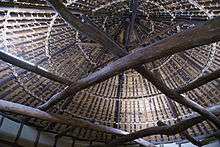 | |
| Woodwork for building (建造物木工 kenzōbutsu mokkō)[55] | Joint (Shoji Matsuura, b. 1929; Association of Conservation Techniques for Cultural Property Buildings) | 1976 |  | |
| Roof-thatching using Japanese cypress bark or boards (檜皮葺・柿葺 hiwada-buki/kokera-buki)[56][57][58] | cf. shake roofing | Joint (Yasuo Onishi, b. 1925; National Organization for Conservation of Roofing Techniques for Temples and Shrines) | 1976 |  |
| Buildings colouration (建造物彩色 kenzōbutsu saishiki)[59] | Group (Organization for Conserving Cultural Properties Related to Shrines and Temples of Nikkō | 1979 |  | |
| Building restoration (建造物修理 kenzōbutsu shūri)[60] | Group (Association of Conservation Techniques for Cultural Property Buildings) | 1976 | | |
| Building decoration (建造物装飾 kenzōbutsu sōshoku)[61] | Group | 2007 | 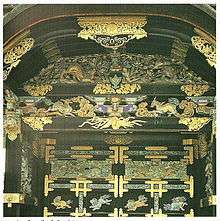 | |
| Plastering (Japanese walls) (左官 (日本壁) sakan (nihon kabe))[62] | Group | 2002 | ||
| Production and repair of festival floats (祭屋台等製作修理 matsuri yataitō seisaku shūri)[63][64] | Group (Association of Holders of Festival Floats Production and Repair Techniques | 2002 | | |
| Traditional framing and mounting techniques (装こう修理技術 sōkō shūri gijutsu)[65] | Group (Federation of National Treasure Framers and Restorers) | 1995 | ||
| Ukiyo-e woodblock art techniques (浮世絵木版画技術 ukiyo-e mokuhanga gijutsu)[66] | Group | 1978 |  | |
| Conservation techniques for Cultural Property dry stone walls (文化財石垣保存技術 bunkazai ishigaki hozon gijutsu)[67][68] | Group | 2009 | | |
| Conservation techniques for gardens designated as Cultural Properties (文化財庭園保存技術 bunkazai teien hozon gijutsu)[69] | Group | 2002 |  | |
| Restoration of wooden sculptures (木造彫刻修理 mokuzō chōkoku-shūri)[70] | Group (Bijutsu-in (Art Institute) | 1976 | 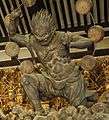 |
Intangible Cultural Properties
31 techniques
| Name | Remarks | Holder | Year | Picture |
|---|---|---|---|---|
| Hair styling for kabuki theatre (歌舞伎床山 kabuki tokoyama)[71] | Individual (Toshikazu Kamoji, b. 1938) | 2003 | _III.jpg) | |
| Crafting and restoration of wind instruments for gagaku music (雅楽管楽器製作修理 gagaku kangakki seisaku shūri)[72] | Individual (Yasuhiko Hukuda, b. 1926; Zenichi Yamada, b. 1934) | 1976 |  | |
| Traditional steel-refining (tatara-buki) (玉鋼製造 (たたら吹き) tamahagane seizō (tatara-buki))[73] | Individual (Akira Kihara, b. 1935; Katsuhiko Watanabe, b. 1939) | 1977 | ||
| Hair styling for traditional Okinawan performing arts (結髪 (沖縄伝統芸能) keppatsu (Okinawa dentō geinō))[74] | Individual | 2008 | ||
| Special charcoal for polishing lacquer or metal handicrafts (研炭製造 togizumi seizō)[75] | Individual (Asatarō Higashi, b. 1921) | 1994 | ||
| Production of brushes for gold/silver lacquer painting (蒔絵筆製作 makie fude seisaku)[76] | for maki-e | Individual (Kurōbei Murata, b. 1915) | 1987 | |
| Production of brushes for lacquer (漆刷毛製作 urushi bake seisaku)[77] | Individual (Seiji Izumi, b. 1950) | 1998 | ||
| Production of tools for lacquer gathering (漆掻き用具製作 urushi kakiyōgu seisaku)[78] | Individual (Humitoshi Nakahata, b. 1943) | 1995 |  | |
| Production of Yoshino-gami paper for filtering lacquer (漆濾紙 (吉野紙) 製作 urushi koshigami (Yoshino gami) seisaku)[79] | Individual (Takao Konbu, b. 1951) | 1999 | ||
| Loom building (手機製作 tebata seisaku)[80] | Individual (Tawaichi Nishimura, b. 1937) | 2003 | ||
| Production of Arasō raw material for textiles (粗苧製造 arasō seizō)[81] | ramie used in kasuri resist-dyeing | Individual (Masakado Yahata, b. 1938) | 2003 | |
| Crafting of kotsuzumi drums and drumheads for nohgaku (能楽小鼓 (胴・革) 製作修理 nōgaku kotsuzumi dōkawa seisaku shūri)[82] | Individual (Satoyuki Suzuki, b. 1936) | 1995 | | |
| Crafting of drumheads for Ōtsuzumi drums used in nohgaku (能楽大鼓 (革) 製作 nōgaku ōtsuzumi kawa seisaku)[83] | Individual (Yukihiko Kimura, b. 1929) | 1976 | ||
| Crafting and restoration of nohkan flute (能管製作修理 nōkan seisaku shūri)[84] | Individual (Hōju Hayashi, b. 1929) | 1978 | | |
| Crafting and restoration of biwa (琵琶製作修理 biwa seisaku shūri)[85] | Individual | 2006 |  | |
| Wig styling for bunraku puppets (文楽人形鬘・床山 bunraku ningyō katsura - tokoyama)[86] | Individual (Shōji Nagoshi, b. 1930) | 2002 | | |
| Production of strings for Japanese stringed instruments (邦楽器糸製作 hōgaki ito seisaku)[87] | for shamisen, koto, wagon, biwa | Individual (Hiroyuki Ozasa, b. 1924) | 1979 | 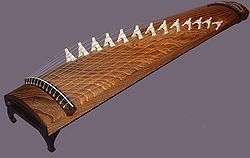 |
| Loom shuttle production (杼製作 hi seisaku)[88] | Individual (Junichi Hasegawa, b. 1933) | 1999 | ||
| Ryūkyū indigo dyestuffs production (琉球藍製造 Ryūkyū ai seizō)[89] | Joint (Seishō Inowa, b. 1927; Organization for Conserving Ryūkyū Indigo Production Techniques) | 1977 | ||
| Karamushi plant production (からむし (苧麻) 生産・苧引き karamushi (choma) seisan - obiki)[90] | ramie | Group (Shōwa-mura Karamushi Production Techniques Conservation Association) | 1991 | |
| Awa indigo production (阿波藍製造 Awa ai seizō)[91] | Group (Organization for Conserving Awa Indigo Production Techniques) | 1978 | ||
| Kabuki stage costume production and restoration (歌舞伎衣裳製作修理 kabuki ishō seisaku shūri)[92] | Group (Association for Conservation of Kabuki Stage Costume Production and Restoration) | 2002 | 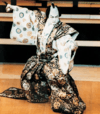 | |
| Kabuki stage properties production (歌舞伎小道具製作 kabuki kodōgu seisaku)[93] | Group (Organization for Conserving Kabuki Stage Properties Production Techniques) | 1996 | ||
| Kabuki stage set (scenery painting) production (歌舞伎大道具 (背景画) 製作 kabuki ōdōgu (haikeiga) seisaku)[94] | Group (Organization for Conserving Kabuki Stage Set Production Techniques) | 2002 | | |
| Production of steel used for making Japanese swords (歌舞伎大道具 (背景画) 製作 tamahagane seizō)[95] | tamahagane | Group (Japanese Association for Conserving Art Swords) | 1977 | 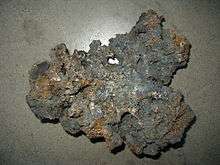 |
| Production of tools for paper making (手漉和紙用具製作 tesuki washi yōgu seisaku)[96] | washi | Group (National Organization for Conserving Production Techniques of Tools for Traditional Paper Making) | 1976 | |
| Natural dyestuffs (safflower and gromwell) production (植物染料 (紅・紫根) 生産・製造 shokubutsu senryō (behi - shikon) seisan - seizō)[97] | Group (Japanese Association for Conserving Ethnic Craft Techniques) | 1979 |  | |
| Kumi Odori tools and costume production and restoration (組踊道具・衣裳製作修理 kumiodori dōgu - ishō seisaku shūri)[98] | Group | 2009 | ||
| Choma thread twisting (苧麻糸手績み choma ito teumi)[99] | Group (Miyako Organization for Conserving Bunmi Techniques) | 2003 | ||
| Production and refining of Japanese lacquer (日本産漆生産・精製 Nihon san urushi seisan - seisei)[100] | Group (Japanese Association of Lacquer for Cultural Properties; Japanese Organization for Conserving Lacquer Gathering Techniques) | 1976 |  | |
| Production of strings for Japanese musical instruments (邦楽器原糸製造 hotsugakki genshi seizō)[101] | Group (Kino-honcho Town Organization for Conserving Production of Strings for Japanese Traditional Musical Instruments; Asai-cho Town Organization for Conserving Production of Strings for Japanese Traditional Musical Instruments) | 1991 |
See also
References
- ↑ "Law for the Protection of Cultural Properties (1950, last amendment 2007)" (PDF). UNESCO. Retrieved 2 May 2011.
- 1 2 "Preservation and Utilization of Cultural Properties" (PDF). Agency for Cultural Affairs. p. 41. Retrieved 2 May 2011.
- 1 2 3 Larsen, Knut Einar (1994). Architectural Preservation in Japan. ICOMOS International Wood Committee. pp. 40f. ISBN 82-519-1432-9.
- ↑ "Database of Cultural Properties". Agency for Cultural Affairs. Retrieved 16 February 2012.
- ↑ "2004 Workshop on Inventory-making for Intangible Cultural Heritage Management" (PDF). Asia/Pacific Centre for UNESCO (ACCU). pp. 200–203. Retrieved 16 February 2012.
- ↑ "屋根瓦製作 (鬼師)". Agency for Cultural Affairs. Retrieved 16 February 2012.
- ↑ "Onigawara". Japanese Architecture and Art Net Users System. Retrieved 4 May 2011.
- ↑ "規矩術 (近世規矩)". Agency for Cultural Affairs. Retrieved 16 February 2012.
- ↑ "Kiku". Japanese Architecture and Art Net Users System. Retrieved 4 May 2011.
- ↑ "規矩術 (古式規矩)". Agency for Cultural Affairs. Retrieved 16 February 2012.
- ↑ "金具鍛冶". Agency for Cultural Affairs. Retrieved 16 February 2012.
- ↑ "Kanagu". Japanese Architecture and Art Net Users System. Retrieved 4 May 2011.
- ↑ "金唐紙製作". Agency for Cultural Affairs. Retrieved 16 February 2012.
- ↑ "Kinkarakami". Takashi Ueda (Bearer of Technique). Retrieved 4 May 2011.
- ↑ "Kinkarakawa". Japanese Architecture and Art Net Users System. Retrieved 4 May 2011.
- ↑ "建具製作". Agency for Cultural Affairs. Retrieved 16 February 2012.
- 1 2 "Tategu". Japanese Architecture and Art Net Users System. Retrieved 4 May 2011.
- ↑ "建造物模型製作". Agency for Cultural Affairs. Retrieved 16 February 2012.
- ↑ "甲冑修理". Agency for Cultural Affairs. Retrieved 16 February 2012.
- ↑ "左官 (古式京壁)". Agency for Cultural Affairs. Retrieved 16 February 2012.
- ↑ "左官 (漆喰塗)". Agency for Cultural Affairs. Retrieved 16 February 2012.
- ↑ "Clay walls". Omotesenke. Retrieved 4 May 2011.
- ↑ "漆工品修理". Agency for Cultural Affairs. Retrieved 16 February 2012.
- ↑ Yagihashi, Shin (1988). "The Preservation and Handing Down of Traditional Urushi Art Techniques in Japan". In Bromelle, N. S.; Smith, Perry. Urushi: Proceedings of the Urushi Study Group, June 10-27, 1985, Tokyo. Getty Conservation Institute. pp. 85f. ISBN 0-89236-096-8.
- ↑ "上代飾金具製作修理". Agency for Cultural Affairs. Retrieved 16 February 2012.
- ↑ "畳製作". Agency for Cultural Affairs. Retrieved 16 February 2012.
- ↑ "石盤葺". Agency for Cultural Affairs. Retrieved 16 February 2012.
- ↑ "竹釘製作". Agency for Cultural Affairs. Retrieved 16 February 2012.
- ↑ "Takekugi". Japanese Architecture and Art Net Users System. Retrieved 4 May 2011.
- ↑ "鋳物製作". Agency for Cultural Affairs. Retrieved 16 February 2012.
- ↑ "唐紙製作". Agency for Cultural Affairs. Retrieved 16 February 2012.
- ↑ "Karakami". Japanese Architecture and Art Net Users System. Retrieved 4 May 2011.
- ↑ "美術工芸品保存桐箱製作". Agency for Cultural Affairs. Retrieved 16 February 2012.
- ↑ "表具用古代裂 (金襴等) 製作". Agency for Cultural Affairs. Retrieved 16 February 2012.
- ↑ "Hyougu". Japanese Architecture and Art Net Users System. Retrieved 4 May 2011.
- ↑ "Kinran". Japanese Architecture and Art Net Users System. Retrieved 4 May 2011.
- ↑ Koyano, Masako (1979). Japanese Scroll Paintings: A Handbook of Mounting Techniques. American Institute for Conservation. ISBN 978-0-933098-01-5.
- ↑ "表具用刷毛製作". Agency for Cultural Affairs. Retrieved 16 February 2012.
- ↑ "Hake". Japanese Architecture and Art Net Users System. Retrieved 4 May 2011.
- ↑ "表具用手漉和紙 (宇陀紙) 製作". Agency for Cultural Affairs. Retrieved 16 February 2012.
- ↑ "表具用手漉和紙 (美栖紙) 製作". Agency for Cultural Affairs. Retrieved 16 February 2012.
- ↑ "表具用手漉和紙 (補修紙) 製作". Agency for Cultural Affairs. Retrieved 16 February 2012.
- ↑ "表具用打刷毛製作". Agency for Cultural Affairs. Retrieved 16 February 2012.
- ↑ "表装建具製作". Agency for Cultural Affairs. Retrieved 16 February 2012.
- ↑ "Hyousou". Japanese Architecture and Art Net Users System. Retrieved 4 May 2011.
- ↑ "本藍染". Agency for Cultural Affairs. Retrieved 16 February 2012.
- ↑ "木工品修理". Agency for Cultural Affairs. Retrieved 16 February 2012.
- ↑ "檜皮採取". Agency for Cultural Affairs. Retrieved 16 February 2012.
- ↑ "錺金具製作". Agency for Cultural Affairs. Retrieved 16 February 2012.
- ↑ "Kazarikanagu". Japanese Architecture and Art Net Users System. Retrieved 4 May 2011.
- ↑ "屋根瓦葺 (本瓦葺)". Agency for Cultural Affairs. Retrieved 16 February 2012.
- ↑ "Hongawarabuki". Japanese Architecture and Art Net Users System. Retrieved 4 May 2011.
- ↑ "茅葺". Agency for Cultural Affairs. Retrieved 16 February 2012.
- ↑ "Kayabuki". Japanese Architecture and Art Net Users System. Retrieved 4 May 2011.
- ↑ "建造物木工". Agency for Cultural Affairs. Retrieved 16 February 2012.
- ↑ "檜皮葺・柿葺". Agency for Cultural Affairs. Retrieved 16 February 2012.
- ↑ "Hiwadabuki". Japanese Architecture and Art Net Users System. Retrieved 4 May 2011.
- ↑ "Kokerabuki". Japanese Architecture and Art Net Users System. Retrieved 4 May 2011.
- ↑ "建造物彩色". Agency for Cultural Affairs. Retrieved 16 February 2012.
- ↑ "建造物修理". Agency for Cultural Affairs. Retrieved 16 February 2012.
- ↑ "建造物装飾". Agency for Cultural Affairs. Retrieved 16 February 2012.
- ↑ "左官 (日本壁)". Agency for Cultural Affairs. Retrieved 16 February 2012.
- ↑ "祭屋台等製作修理". Agency for Cultural Affairs. Retrieved 16 February 2012.
- ↑ "Dashi". Japanese Architecture and Art Net Users System. Retrieved 4 May 2011.
- ↑ "装こう修理技術". Agency for Cultural Affairs. Retrieved 16 February 2012.
- ↑ "浮世絵木版画技術". Agency for Cultural Affairs. Retrieved 16 February 2012.
- ↑ "文化財石垣保存技術". Agency for Cultural Affairs. Retrieved 16 February 2012.
- ↑ "Ishigaki". Japanese Architecture and Art Net Users System. Retrieved 4 May 2011.
- ↑ "文化財庭園保存技術". Agency for Cultural Affairs. Retrieved 16 February 2012.
- ↑ "木造彫刻修理". Agency for Cultural Affairs. Retrieved 16 February 2012.
- ↑ "歌舞伎床山". Agency for Cultural Affairs. Retrieved 15 February 2012.
- ↑ "雅楽管楽器製作修理". Agency for Cultural Affairs. Retrieved 15 February 2012.
- ↑ "玉鋼製造 (たたら吹き)". Agency for Cultural Affairs. Retrieved 15 February 2012.
- ↑ "結髪 (沖縄伝統芸能)". Agency for Cultural Affairs. Retrieved 15 February 2012.
- ↑ "研炭製造". Agency for Cultural Affairs. Retrieved 15 February 2012.
- ↑ "蒔絵筆製作". Agency for Cultural Affairs. Retrieved 15 February 2012.
- ↑ "漆刷毛製作". Agency for Cultural Affairs. Retrieved 15 February 2012.
- ↑ "漆掻き用具製作". Agency for Cultural Affairs. Retrieved 15 February 2012.
- ↑ "漆濾紙 (吉野紙) 製作". Agency for Cultural Affairs. Retrieved 15 February 2012.
- ↑ "手機製作". Agency for Cultural Affairs. Retrieved 15 February 2012.
- ↑ "粗苧製造". Agency for Cultural Affairs. Retrieved 15 February 2012.
- ↑ "能楽小鼓 (胴・革) 製作修理". Agency for Cultural Affairs. Retrieved 15 February 2012.
- ↑ "能楽大鼓 (革) 製作". Agency for Cultural Affairs. Retrieved 15 February 2012.
- ↑ "能管製作修理". Agency for Cultural Affairs. Retrieved 15 February 2012.
- ↑ "琵琶製作修理". Agency for Cultural Affairs. Retrieved 15 February 2012.
- ↑ "文楽人形鬘・床山". Agency for Cultural Affairs. Retrieved 15 February 2012.
- ↑ "邦楽器糸製作". Agency for Cultural Affairs. Retrieved 15 February 2012.
- ↑ "杼製作". Agency for Cultural Affairs. Retrieved 15 February 2012.
- ↑ "琉球藍製造". Agency for Cultural Affairs. Retrieved 15 February 2012.
- ↑ "からむし (苧麻) 生産・苧引き". Agency for Cultural Affairs. Retrieved 15 February 2012.
- ↑ "阿波藍製造". Agency for Cultural Affairs. Retrieved 15 February 2012.
- ↑ "歌舞伎衣裳製作修理". Agency for Cultural Affairs. Retrieved 15 February 2012.
- ↑ "歌舞伎小道具製作". Agency for Cultural Affairs. Retrieved 15 February 2012.
- ↑ "歌舞伎大道具 (背景画) 製作". Agency for Cultural Affairs. Retrieved 15 February 2012.
- ↑ "玉鋼製造". Agency for Cultural Affairs. Retrieved 15 February 2012.
- ↑ "手漉和紙用具製作". Agency for Cultural Affairs. Retrieved 15 February 2012.
- ↑ "植物染料 (紅・紫根) 生産・製造". Agency for Cultural Affairs. Retrieved 15 February 2012.
- ↑ "組踊道具・衣裳製作修理". Agency for Cultural Affairs. Retrieved 15 February 2012.
- ↑ "苧麻糸手績み". Agency for Cultural Affairs. Retrieved 15 February 2012.
- ↑ "日本産漆生産・精製". Agency for Cultural Affairs. Retrieved 15 February 2012.
- ↑ "邦楽器原糸製造". Agency for Cultural Affairs. Retrieved 15 February 2012.
External links
- (Japanese) Cultural Properties database
- (Japanese) Association for the Conservation of National Treasures
- (English) Association for the Conservation of National Treasures
- (English) Conservation and Repair Projects: systems and planning